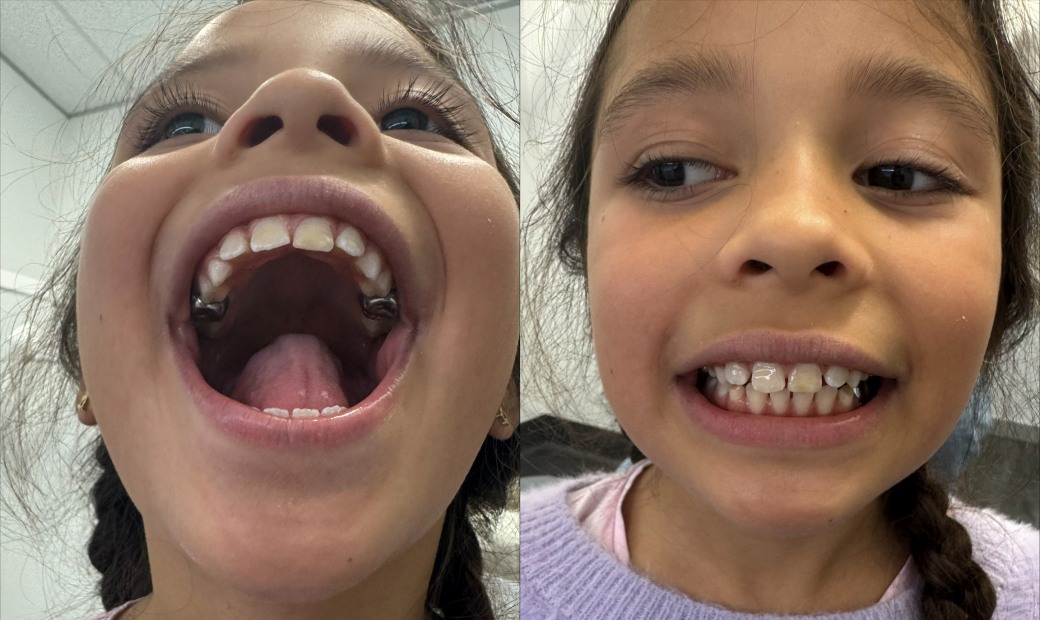Stainless steel crowns (SSCs) are an increasingly common and effective treatment option for children with decayed baby teeth, and we love to do them here at Floss Family Dental. These pre-fabricated crowns are used to restore teeth that are damaged by decay rather than traditional fillings.
What are Stainless Steel Crowns?
Stainless steel crowns are metal caps that fit over a decayed or damaged tooth to restore its shape, size, and function. They are durable, cost-effective, and generally last until the baby tooth naturally falls out.
Benefits of Stainless Steel Crowns
1. Durability: SSCs are strong and can withstand the forces of chewing and grinding.
2. Longevity: Unlike some traditional fillings in baby teeth, crowns last until the baby tooth falls out naturally. Very rarely do they need to be replaced before the tooth naturally falls out.
3. Protection: Provides full coverage to protect the tooth from further decay and damage.

Procedure
There are generally two ways of placing stainless steel crowns
Option 1: (most minimally invasive, and done over 2 appointments)
Silver fluoride: a desensitising agent is gently applied to the decayed tooth – this helps to stop the progression of decay, and reduces the amount of discomfort your child experiences from the decay.
Separator bands: separator bands are gently placed either side of the decayed tooth. These are left in place for at least 3-5 days to allow natural movement of the teeth, so that the crown fits right over the top & there is no need for drilling. They can cause some discomfort for the first hour or so, but children generally forget they are there by the end of the day. It is important these bands stay in place to allow the natural movement of the teeth – if they fall out (which can happen as the teeth move), it’s important to let us know so we can put them back in. Your child should use gentle brushing around this area, avoid flossing and eating sticky foods that could dislodge the band.
Placement: 3-5 days later, your child returns to our practice for the crown. The separator bands are taken out and there should be enough room for the SSC to fit over the top without any drilling. The stainless steel crown is selected and adjusted to fit the tooth perfectly.
Fitting: The crown is seated using special dental glue to hold it in place. Your child is able to help us ‘seat’ it in the correct position by biting down onto a soft cotton roll “pillow”. Then we ensure it can be flossed so your child can continue to take care of this tooth until it falls out.
Option 2: (invasive – similar to traditional filling appointment)
If for some reason we are not able to place the separator bands, or you are not able to come back 3-5 days later for the crown, we can do it another way. This way, however, is more invasive, and does involve numbing the tooth (needle), and loud noises & water from the drilling. Your child will also have to be able to sit still and wide enough for us to prepare the tooth.
Numbing the tooth: a numbing agent (gel) will be applied to the gum around the decayed tooth for 2 minutes. Then the tooth will be numbed with local anaesthetic.
Preparation: your dentist or oral health therapist will prepare the decayed tooth with a drill, in order to make enough room for the pre-formed crown to fit over.
Fitting: The stainless steel crown is selected and adjusted to fit the tooth perfectly.
Cementing: The crown is seated using special dental glue to hold it in place. Your child is able to help us ‘seat’ it in the correct position by biting down onto a soft cotton roll “pillow”. Then we ensure it can be flossed so your child can continue to take care of this tooth until it falls out.
Aftercare
You can imagine after having bands stuck in between their teeth and gums for 3-5 days can cause some inflammation and discomfort. Some children require pain relief (panadol, neurofen) after the crown is placed, however it will feel back to normal within a couple of hours.
Just because this tooth is covered with a crown doesn’t mean children with crowns don’t have to look after them now. Children with stainless steel crowns should:
- Maintain good oral hygiene, brushing twice a day and flossing regularly.
- Attend regular dental check-ups to monitor the condition of the crown and the underlying tooth.
Conclusion
Stainless steel crowns are an excellent option for treating decayed baby teeth, offering durability, cost-effectiveness, and full protection of the tooth. Parents should discuss with their dental provider whether SSCs are the best option for their child’s dental health needs.
